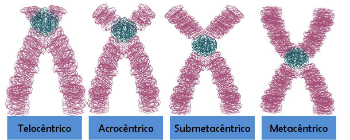Chromosomes are spirally chromatin strands present in the nucleus of all cells.
Chromatin is formed by DNA molecules associated with proteins of two classes, the histones and non-histone chromosomes.
Chromatin can take the form of euchromatin or heterochromatin:
- Euchromatin: Consists of active DNA that can carry out transcription.
- heterochromatin: It consists of heavily condensed, inactive DNA that cannot transcribe genes.
What is the difference between the chromosome and chromatin?
The two structures are made up of DNA, the difference between them is the state they are in.
Chromatin is a long, thin strand of DNA found during interphase, a phase in which the cell is not dividing.
Each chromatin filament constitutes a chromosome. The chromosome is the chromatin "coiled" in on itself, taking on a spiral and condensed form, when the cell goes into division.
Therefore, the chromosome corresponds to condensed chromatin. To get an idea of the degree of condensation, the chromosome is the only visible structure during cell division.

chromosome formation
A chromosome can be demarcated along its length into thousands of regions called a genes.
The function of chromosomes is to control the functions of cells. In addition, they carry an individual's genetic information through the genes.
Structure
The chromosome has a filamentous structural unit of DNA in the form of a spiral, being surrounded by a protein substance called matrix.
Chromosome Parts
 chromosome structure
chromosome structure
The parts of the chromosome are:
- Chromomers: These are very irregular thickenings with a grainy appearance, present throughout the entire length of the chromatin;
- Chromatid: Are the result of the longitudinal division of the chromosome during cell division;
- centromere: Primary constriction that divides the chromosome into 2 arms and influences movement during cell division. There is usually a single centromere per chromosome, although there are dicentric or polycentric organisms;
- Satellite: Terminal part of chromosomal material separated from the chromosome by a secondary constriction;
- SAT Zone: Portion of the chromosome related to the formation of the nucleolus during telophase;
- Telomeres: End ends of chromosomes that protect it from degradation.
In the metaphase and anaphase of cell division, the filaments of chromosomes are more compact and condensed, making their study easier.
See too: mitosis and meiosis
DNA and Histones
The association between DNA and histone proteins is another important aspect of chromosome structure.
They form a complex since histones are positively charged and the phosphate groups in DNA have negative charges.
There are 5 different types of histones (H1, 2 H2A, 2 H2B and 2 H3), which are distinguished according to the lysine/arginine ratio.
Histones increase the diameter of DNA and also alter its physical properties.
For example, the melting temperature, at which DNA strands change from regular double helix to single strand shape, is greatly increased due to histones.
Chromosome Types
The classification of chromosomes occurs according to the position of the centromeres.
- metacentric: Centromere in median position. Both arms are the same size.
- acrocentric: Centromere near one end of the chromosome. One of the arms gets bigger and the other smaller.
- Telocentric: Centromere at one end. The chromosome has a single arm;
- Submetacentric: Centromere slightly displaced from the median region. Arms are unequal sizes.

Chromosome Types
Read too:
- Cell Core
- 8 Superpowers of the Human Body Cells
- Cell
Human Chromosomes
The karyotype is the set of chromosomes of a species.
Thus, the human karyotype has 23 pairs of chromosomes. In diploid organisms, somatic cells have 2n chromosomes, because 23 chromosomes had maternal origin and the other 23 had paternal origin.
Thus, a total of 46 received chromosomes. Of these, 44 are chromosomes autosomes, found in all somatic cells. While 2 of them are sex chromosomes, being "X" the female chromosome and "Y" the male chromosome.
Understand how the sex linked inheritance.
Women have pairs "XX" and men "XY".

Human karyotype of a male individual
Any type of change in the number and structure of the chromosomes gives rise to mutation.
An example of a mutation is the Down's syndrome, caused by the presence of an extra chromosome in pair 21, hence it is also known as Trisomy 21.
Homologous Chromosomes
 Representation of homologous chromosomes and the location (gene locus) of some allele genes, which determine specific characteristics.
Representation of homologous chromosomes and the location (gene locus) of some allele genes, which determine specific characteristics.
You homologous chromosomes they have the same size and maintain the same relative position of the centromeres.
Homologous chromosomes are related to the allele genes. These genes occupy the same gene locus on homologous chromosomes and are involved in determining the same character.
Also know about Genes and Chromosomes.
Number of Chromosomes
Know the number of chromosomes in some species. Note that the number of chromosomes has nothing to do with the individual's complexity.
- Humans: 46
- Horse: 66
- Opossum: 22
- Cucumber: 14
- Papaya: 18
- Oats: 42
- Dog: 78
- Potato: 48
Want to learn more concepts related to Genetics? Read too Introduction to Genetics.



